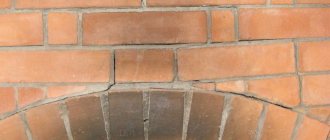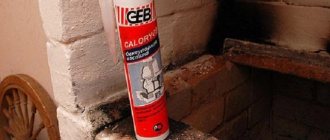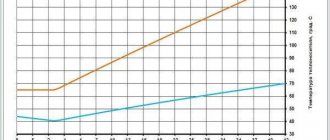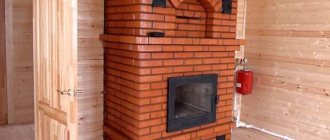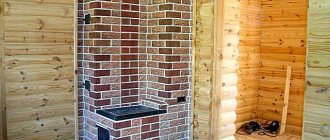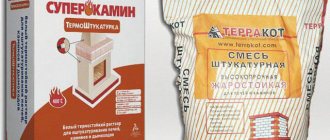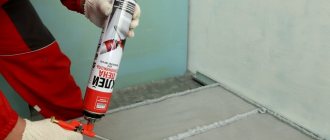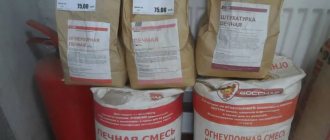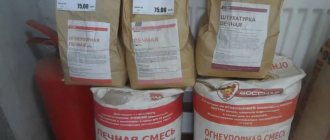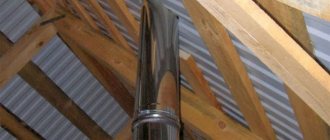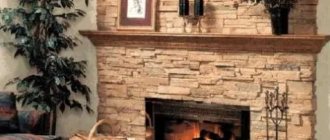The laying of fireplaces and stoves has a number of features, because the structure will be constantly exposed to high temperatures. In this regard, for the process you need to choose a special glue for stoves and fireplaces; it will help preserve the structure and will not collapse or crack in such conditions. More details about what properties a high-quality fire-resistant adhesive should have and what types exist will be discussed below.
Heat-resistant adhesive for stoves and fireplaces
Heat-resistant mixtures are produced in separate types for bricklaying or the base and cladding of the finished structure.
Heat-resistant adhesive for ovens must have:
- fire resistance;
- plasticity to create an even coating;
- ability to withstand temperature changes.
The heat-resistant compound provides a protective layer between the fireplace and the tiles. Helps avoid deformation of the cladding.
What components should be included?
Plasticizers and synthetic additives are added to the composition of ready-made dry mixtures. In addition, the following components are added to heat-resistant fireplace adhesive:
- sand;
- chalk;
- cement;
- mineral inclusions;
- pulp;
- fireclay
The adhesive composition varies depending on the characteristics and popularity of the manufacturer.
Masonry mortar for stoves and fireplaces
Recommendations for use
How to work with glue is described in detail in the instructions. But there are some general recommendations .
- The surface for cladding must be thoroughly cleaned, especially from oil and grease stains - they reduce adhesion. If the base is highly absorbent, it is first treated with a primer.
- Dry mixtures are prepared 2 hours before work: after mixing, they need about an hour to settle. You need to dilute the glue with clean water, preferably filtered.
- To obtain a homogeneous mixture, it is recommended to use a drill with an attachment or a mixer.
- The adhesive is applied in a thin layer, both when installing tiles and when laying bricks. This is his advantage.
Heat-resistant and heat-resistant mixtures are used not only for the construction of stoves or laying porcelain stoneware. They are used in the repair of heaters, microwaves, and electric ovens.
Kinds
Depending on the composition and additives included in it, there are different types of glue for ovens. The components filling it also depend on the purpose of the substance. For the chimney you need heat-resistant, for the base - heat-resistant, for masonry - heat and moisture resistant. Adhesives are sold in the form of a ready-made solution or dry powder. The liquid mixture is similar to jelly and is immediately ready for use. A solution is prepared from the dry substance by diluting it with water.
The difference between heat-resistant glue and heat-resistant glue
Adhesives for lining stoves and fireplaces have special plasticity. Universal compositions are preferable for work, as they save time and effort. But they do not always correspond to the desired temperature.
Refractory mixtures do not change their properties when exposed to an open flame for 180 minutes. They are also resistant to chemicals. Heat-resistant can withstand heating up to 1000°C. Heat-resistant retain their quality under prolonged heat exposure up to 140°C.
A universal composition, the disadvantage of which is its high price, is a heat-resistant material with soapstone chlorite as a plasticizer. The filler is quartz sand, binding components: kaolin, aluminosilicate cement.
Pros:
- excellent adhesion;
- heat-intensive;
- with good thermal conductivity;
- the seams are strong;
- heat resistance up to 1500°C.
Thermo, heat, fire, etc. – how is that?
Professionals usually use universal glue for fireplaces; this greatly speeds up the work and allows them to charge the customer less without sacrificing their own profits. If the fireplace in the house is built independently gradually, then for its individual parts it is possible to use adhesives with different characteristics, see fig., which will significantly reduce the overall costs of materials.
What stove adhesives can be used to build and cladding a fireplace?
Note: the adhesive parameters for the base of the fireplace are given, of course, for emergencies; in a residential building, minus under the floor is an accident. However, the structure of the stove/fireplace is mechanically connected to the building structures. If for any reason the house remains unheated for a long time in the winter, damage to the structure of the stove/fireplace can lead the entire house into disrepair. Therefore, you should under no circumstances neglect the quality of the foundation, hoping that the stove is supposedly on a separate foundation.
“Thermo”, “fire”, “heat” strength, stability and durability in the popular concept are often merged into one, but in fact they characterize different properties of the glue:
- heat-resistant - withstands temperatures of at least 140 degrees for a certain time (3 hours for building structures) without deteriorating technical parameters;
- thermally stable – capable of maintaining specified properties indefinitely at temperatures not lower than +140, which may differ from them at room temperature;
- heat-resistant – properties at +20 are completely retained within the specified temperature range. Default – (–10 – +140 degrees Celsius);
- heat-resistant, heat-resistant, heat-resistant - the same as in paragraphs. 1-3, but the default temperature is 1000 degrees.
- fire-resistant – withstands specified parameters in contact with an open flame for at least 3 hours. It is always chemically resistant, since the visible part of the flame is saturated with chemically active particles of fuel that has not yet burned;
- fireproof - the same as according to item 5, but unlimited time.
Note: Heat-resistant and heat-resistant general purpose adhesives are also fire-resistant and flame-retardant respectively by default.
In addition to chemical and thermal resistance, the modulus of the coefficient of thermal expansion (TCR) of a completely dried adhesive layer is of great importance; it must be consistent with the TKR of both bonded surfaces. For finishing adhesives, the determining parameter may be adhesive ability (simply the stickiness of the working solution). Adhesiveness is directly related to viscosity: viscous glue with too little adhesion will not hold the cladding parts on a vertical/steeply inclined surface, but excessively sticky and liquid will creep down along with it. For masonry adhesives, the strength and gas tightness of the seam is important; for any adhesives - the plasticity of the dried seam, because Full agreement on TKR is impossible.
Note: the ductility of the dried joint of mineral-based adhesives strongly depends on its thickness, which should be maintained within the limits specified in the instructions.
How to choose
The adhesive is selected in accordance with the customer’s financial capabilities and the conditions in which the composition will subsequently be located. Operating temperature, setting speed, environmental friendliness and resistance to external factors are important.
| Name | Price |
| 1. Astrochim AC-9315 | up to 100 rub. |
| 2. KS universal glue | up to 900 rub. |
| 3. Founds oven mold AC150 | up to 800 rub. |
| 4. IRFIX +1500 High Temperature Sealant | up to 250 rub. |
| 5. UHU 46670 Metall | up to 300 rub. |
Other selection factors
When purchasing fireproof adhesive for a tile stove, other factors are taken into account:
- Frost resistance is an important factor when the stove is located in a room with non-permanent occupants, when there is a possibility of negative temperatures in winter. If the glue does not have this property, there is a risk of cracking the tiles.
- Material – more durable tiles require adhesive with a higher level of adhesion.
- The cladding factor - stone reduces adhesion, but fireclay brick increases it.
- Operating mode - if the stove is often heated and extinguished, this puts a greater load on the materials than a constantly operating device.
- Additional loads, vibrations. They affect long-term operation and violate the properties of materials.
Based on these factors, you can choose the ideal glue. Of the different options, you need to choose the one that best suits the operating conditions.
Popular brands
The level of quality from reliable manufacturers also matters.
"Stove Man"
The glue is ready to go. Contains additives that increase resistance to temperatures of 1600°C. Suitable for lining stoves and fireplaces. Dries completely within a week. With the help of the “Stove Maker”, porcelain tiles, tiles, and finishing stones are installed. The glue is durable and highly flexible.
Terracotta
The adhesive for masonry stoves is based on terracotta clay. Suitable for installation of fireplaces. Various types of tiles, brick, natural and artificial stone are attached to it. Requires pre-soaking for an hour.
Lay the brick in 2-3 rows, then stop working until the composition hardens.
PalaTERMO-601
The universal composition can withstand heating up to 150°C. Designed for cladding stoves and fireplaces with clinker tiles, porcelain tiles, and finishing stones. Fireproof tile adhesive copes with sudden temperature changes from hot to freezing. It consists of high quality cement, a complex of modifying additives that make the adhesive solution elastic.
Which one should I take?
Knowledge of the physicochemical properties of the oven adhesive base greatly simplifies its choice, but it is also necessary to keep in mind the scope of application specified by the manufacturer. For example, Terracotta Superfireplace is a good masonry adhesive, but the manufacturer guarantees the reliability of the cladding on it only if it is also made of terracotta tiles. The base of the Terracotta Superfireplace is clay-cement-fireclay, and therefore facing materials need to be placed on it in belts of 2-4 rows with breaks for the glue to set. How to line a stove with terracotta, see next. video:
Video: finishing the stove with terracotta
Glue Plitonit SuperKamin Ogneupor can also be used for masonry, it is a good heat-resistant adhesive for the oven, but the best domestic one for this purpose is K-77, which is essentially an oven masonry adhesive based on aluminosilicates. Besides the expensive ScannMix , it is perhaps the only option for laying the base of a fireplace/stove, because... maintains high sub-zero temperatures, does not allow moisture and its vapors to pass through.
Profix , Hercules and Ivsil termix adhesives are intended for tiles, but the first according to TKR “specializes” in tiles, Hercules is suitable for any cladding of a fireplace or stove tent, incl. heavy (natural stone), and Ivsil termix has proven itself well on the portals of wood-burning fireplaces with fireclay open fireboxes. As for Polymin P11 and Ceresit C16 and C17, these are heat-resistant general purpose adhesives; the lining on them holds tightly only if the fireplace has a factory-made metal firebox with glass.
Note: there is a fairly wide selection of tile stove adhesives of Belarusian and Ukrainian production on sale. However, the upper limit of heat resistance of the former is, as a rule, 180, and for the latter 150 degrees, which is sufficient, at best, for cladding a fireplace tent with a finished closed firebox. Are they saving on raw materials, or what?
How to make it yourself
Previously, only clay was used for laying stoves. With the development of the chemical industry, a heat-resistant composition became the fastening material.
But methods of creating solutions with your own hands are still popular. The main masonry is mounted on a mixture of clay, sand and cement. And the structure is lined with heat-resistant glue for stoves and fireplaces.
Clay composition
To create the main structure of the furnace and also for its lining, clay mortar is used. It is prepared like this: add 1 part filler to 2 parts clay. The mixture is diluted with water. The filler is shavings, sawdust, and construction sand.
To give greater strength to the clay solution, add table salt. 150-200 g of the substance are dissolved in a 10 liter bucket of water.
A clay-sand mortar is also mixed as masonry.
How to prepare clay mortar for laying a stove with your own hands.
Cement-clay mixture
The composition has high adhesive properties. Prepared from several parts:
- ¾ sand;
- ¼ chalk;
- ¼ clay;
- ¼ cement.
The mixture is prepared in dry form, first without clay. It is added at the end. Liquid glass is suitable as an additive.
The composition is suitable for installing large tiles and heavy tiles.
Mortar
The mixture is prepared from sand and lime in a 3:1 ratio. The solution is heat resistant. Used for brickwork. It is not recommended to apply cladding to it.
Cement mortar
Cement is less often added to the composition for laying a stove. You will need 750 g of it per bucket of water. Used for finishing horizontal surfaces.
Sand-cement mortar is used for the base of the furnace, when sealing joints. The composition proportions are as follows: 2 parts sand: 1 part cement. The solution is prepared as follows:
- construction sand is mixed with cement in the required quantity;
- mix well together;
- pour water so that the composition is mobile.
The composition should be squeezed out of the seam without much pressure.
To strengthen the masonry and increase gas-tightness properties, treat the seams with heat-resistant silicone sealant. It will prevent possible deformation of materials during thermal expansion.
Making a composition with sand, cement and heat-resistant glue with your own hands. Professional method.
How to Carefully Apply Heat Resistant Sealant
To make it convenient to repair a stove or chimney using sealant, you need to prepare some tools and materials.
So, you will need:
- Construction mounting gun or syringe.
- Rubber spatula.
- Stationery knife.
- A gas burner and, accordingly, a refilled cartridge for it.
- Sealing compound in the cartridge.
- Masking tape.
- Latex gloves.
In the case when the paste is purchased in a tube, a construction syringe is not required, and when using a heat-resistant sealant, there is no need to prepare a burner and a gas cylinder for use.
Sealing joints between bricks requires special care
When applying sealant to surfaces, special care is required when filling seams or cracks, especially if it is necessary to maintain the neat appearance of the masonry, made “for jointing”
To carry out such work efficiently, it is advisable to take into account a couple of tips from experienced craftsmen:
In order not to stain the surface of the brickwork with sealant, a reasonable solution would be to seal it with masking tape, leaving only gaps along the line of the seams being sealed.
To prevent the sealant from getting on the surface of the brick and filling only a crack or seam, the surfaces can be sealed with masking tape of the required width. The tape is glued along the seam line, then the gap is filled with sealing paste, approximately one centimeter deep. If necessary, the sealant is leveled with a rubber spatula and there is no need to be afraid that the dark composition will stain the surface of the wall. After the paste has set, the tape is removed. This method will allow you to keep the seams in their original width and not spoil the neat appearance of the brickwork with dark paste.
The tube spout is cut so that the hole is slightly beveled, and its diameter is slightly less than the width of the seams being sealed.
You can solve this problem in another way, without using tape. To do this, when preparing the tube for work, you should not immediately cut off its spout to the maximum. In addition, the cut should be made at a slight angle and so that the hole is 2-3 mm smaller than the width of the seam - this will help control the amount of sealant squeezed out. True, with this approach there remains a risk of accidental contact of the composition with the surface of the brick, so using adhesive tape is definitely the best solution.
Having taken into account these recommendations, you can proceed directly to the process of applying the sealing composition. The work is carried out in the following order:. The first step is to cut off the sealed cap that closes the tube from the cartridge using a sharp knife
The first step is to cut off the sealed cap that closes the tube from the cartridge using a sharp knife.
This cap is cut off completely, across its entire width.
- Next, a spout is screwed onto it, which is already cut as recommended above
- The next step is to install the tube into a mounting gun, which is prepared for work in accordance with the specific features of its design.
When working with a mounting gun, you must rely on the instructions for its use - there may be differences
Next, before applying sealant to the seam, crack or gap between the brick and the cast iron part, the surface must be carefully prepared:
- Clean from dust and dirt.
— A surface that is too smooth must be treated with sandpaper to increase adhesion, and then cleaned again.
— After this, the surfaces are degreased and completely dried. To speed up this stage of work, you can use a hair dryer for drying.
Filling the seam between bricks with heat-resistant sealant
- When the surface is dry, you can begin to fill the gap with a sealing mixture.
- Further, if a heat-resistant paste was used for sealing, then it is left to dry for a while. The packaging usually indicates the exact duration of the drying period for the sealant before the next stage of work can begin. Usually this period is about a day.
After the composition has hardened according to the instructions, it is recommended to burn it with a gas burner flame
The final step is firing the hardened layer of sealant using a portable gas burner. After such treatment, the material will be able to withstand temperatures of up to 1500 degrees during operation.
Of course, only one of the commercially available sealants was shown as an example. For other compositions, there may be some differences in application technology. In any case, you must carefully study the instructions supplied by the manufacturer.
How to work with glue
Before you begin, you need to prepare the foundation. The surface on which the heat-resistant adhesive will be applied is first cleaned of dirt and dust. Severe cracks are sealed with putty.
Before applying heat-resistant adhesive to the wall, it is necessary to prime the surface. The composition is also selected to be heat-resistant.
Before laying, soak the facing tiles for the stove or fireplace in water for a short time. This will improve adhesion to the adhesive.
The bonding agent is diluted according to the instructions.
Installation of the device using oven glue:
- The diluted or prepared composition is applied to the surface using a notched trowel.
- The glue line should not be higher than 1 cm.
- Lay tiles or bricks.
- Important! This must be done within 10 minutes, otherwise the glue will dry out.
- Press firmly and hold for 4-5 minutes.
- You must wait 48 hours before grouting.
An adhesive compound with heat-resistant properties has no application features or contraindications. It is important to follow the instructions for use and safety precautions.
Composition of facing adhesive
Manufacturers are trying to make glue compositions as universal as possible, but at the same time improve some qualities:
Installing tiles using heat-resistant cladding adhesive
- heat resistance;
- moisture resistance;
- plastic;
- heat exchange;
- linear expansion;
- environmental friendliness.
To do this, various synthetic components are added to the composition, ensuring the performance of the above functions with a predominance of several. Those compositions that meet all the criteria are considered universal, for example, Profix, Scanmix Fire, Terracotta, their cost will be correspondingly more expensive. We can distinguish the main components that are present in all adhesive mixtures:
- cement;
- sand;
- fireclay fibers;
- mineral components;
- synthetic additives.
Technical characteristics of cement
Cement provides strength, minerals provide plasticity, fireclay fibers provide heat resistance, and synthetic components provide moisture resistance, heat transfer, and linear expansion. The predominance of a certain component can increase one characteristic, but at the same time negatively affect others. Therefore, there are two types of glue for fireplaces:
- for finishing the portal;
- for basic brick or stone masonry.
Safety regulations
Hot melt adhesive, like other building materials, due to its chemical composition, has qualities that require compliance with safety measures.
To protect your respiratory system when working with dry glue in powder form, use a respirator. Protect your eyes with glasses.
If the already diluted composition gets on the skin, it is necessary to immediately remove and rinse with water. Otherwise, a chemical burn may occur.
The use of heat-resistant compounds for laying stoves and fireplaces allows you to achieve excellent results. Subsequently, the structure will be exposed to high temperatures. And it is the fireproof glue that will prevent the device from falling apart.
Requirements for compositions for furnace lining
Standard tile adhesive is not suitable for finishing surfaces that are in close proximity to fire. The material will be constantly exposed to temperatures. You need to choose a heat-resistant, durable glue. Otherwise, changes will occur that will lead to deformation.
When choosing a lining for a stove, it is important to focus on the following characteristics:
- Heat resistance.
- High level of adhesion.
- Safety.
- Elasticity of the adhesive.
Heat resistance
You can find out that the mixture is heat-resistant from the information on the packaging. However, ordinary high-temperature compounds, which are used in conditions up to 50 degrees, should not be confused with heat-resistant ones. Glue for fireplaces must retain its quality at +175 degrees and temporary heating up to +1200 degrees. On the packaging, in addition to this indicator, it is said that it is suitable specifically for stoves and other heated surfaces.
Adhesion level
Furnaces are finished with high-adhesion ceramics. Its thickness is not less than 0.8 cm. To fix the cladding, a composition with a high level of adhesion must be used, otherwise strong fixation cannot be achieved.
Increased elasticity
Under the influence of extreme conditions, materials deform, decrease or increase. Once cured, the adhesive must remain flexible enough to compensate for the difference in expansion.
To lay ceramics on the stove, you cannot use glue intended for other materials (brick). The reinforcing substances in it prevent expansion.
Safety
Exposure to temperature deforms and leads to the destruction of components and the release of toxic elements. Heat-resistant adhesive must not contain harmful gases.
Types of non-combustible high-temperature insulating materials by production method
All types of high-temperature insulation differ from each other in the production method and composition of raw materials. Below are the main high temperature insulation products found in the construction markets. Both long-proven and new high-tech ones are described.
- The oldest non-combustible material widely used in industry is mineral wool. Produced from waste from the metallurgical industry and quartz sand. One of the cheapest. Can be produced in the form of plates and canvas. Less commonly, it is packaged with cotton wool in bags and used to fill voids during construction, for example, houses. For insulation of high temperatures it is used only in combination with more heat-resistant products.
- Expanded clay, perlite and vermiculite are loose granules; for thermal insulation they are used only in a mixture with other substances, for example, for installing heated floors in rooms.
- Fire-resistant foam is a product obtained by foaming polyurethane into which fire retardants are added for fire protection.
- Velite is foamed concrete with a porous structure, which reduces its weight and density.
- Glasspore. This bulk composition is obtained by melting potassium or sodium glass, followed by rapid cooling of the composition. It is not used independently, but only as part of mixtures, where it is added as a means to increase fire resistance. Piece products that resist fire are made from it.
- Basalt thermal insulation material, made from molten basalt, is one of the safest to use, withstanding high temperatures. Widely distributed due to its versatility. Can be used for indoor and outdoor work, and in conditions of high humidity.
- Foam glass. It is obtained by sintering broken glass using coal, which is added for the gas formation reaction. It does not burn at all, conducts almost no heat, and can withstand enormous temperatures. Most often used for thermal insulation of rooms with wet technological processes.
